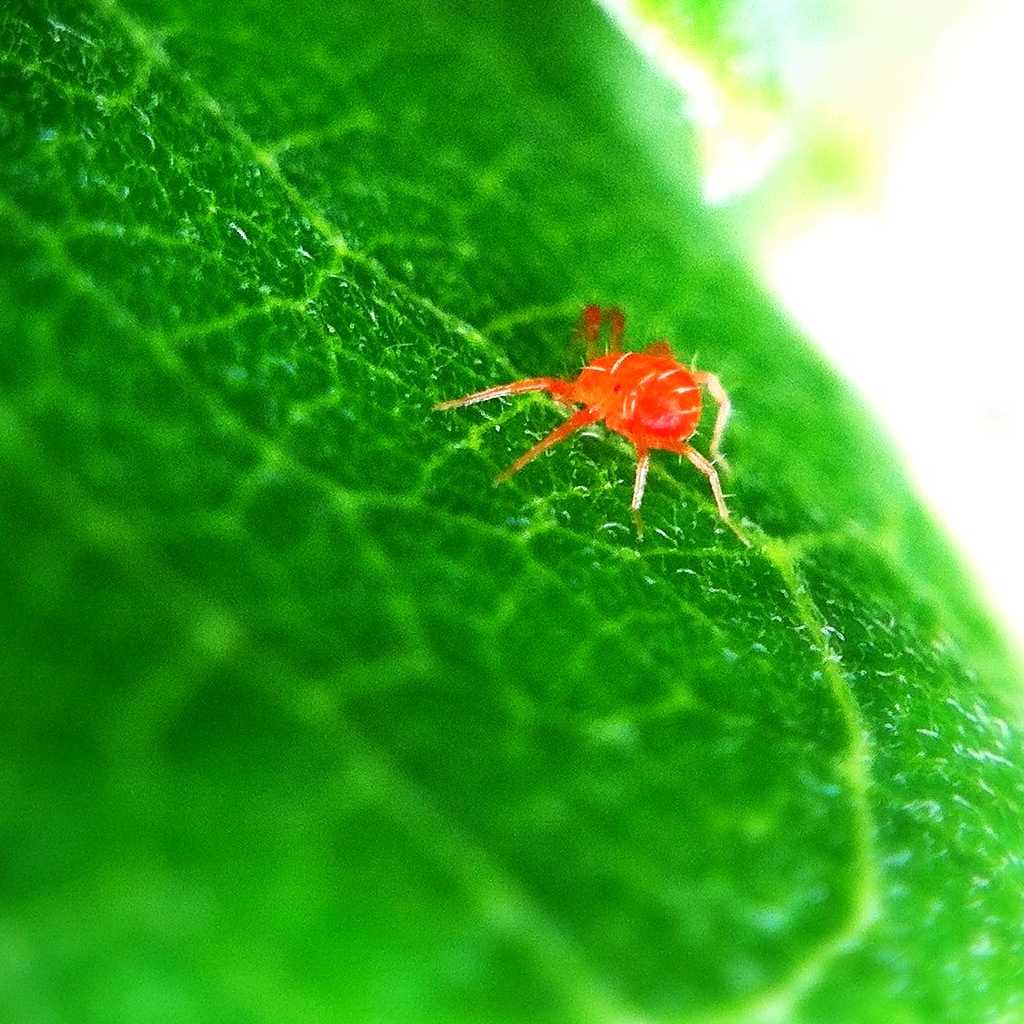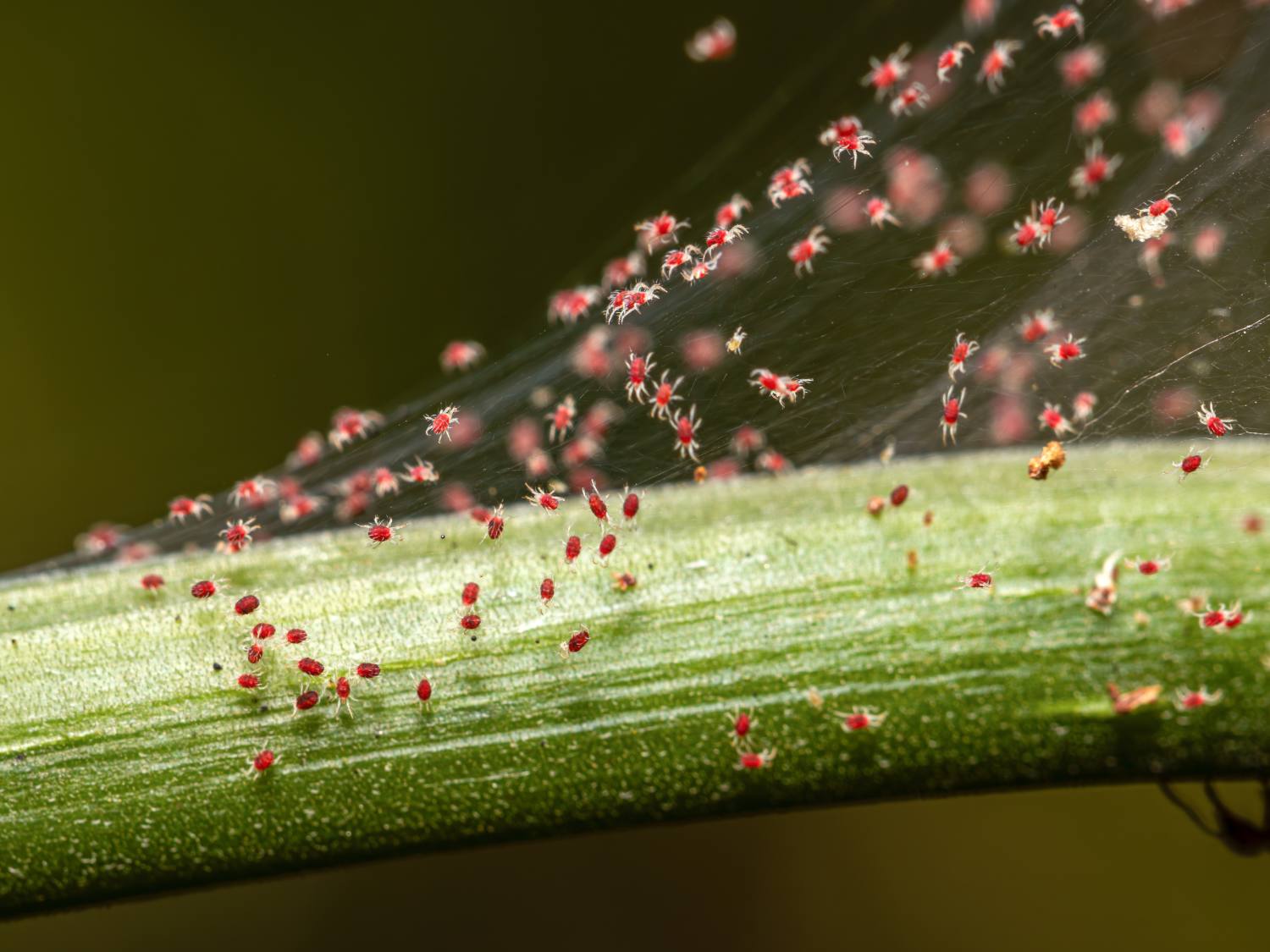
“Spider mites can quickly damage plants, leaving yellow spots and fine webbing. Control them with neem oil, insecticidal soap, or natural predators, while boosting humidity and airflow. Regular checks and early treatment are key to keeping your grow space spider mite–free.”
"Red spider mite - treating and fighting ..." from www.nature-and-garden.com and used with no modifications.
Spider mites can be a gardener's nightmare, quickly turning lush green leaves into a webbed mess. But fear not! With the right approach, you can eliminate these pesky invaders swiftly and effectively. Let's dive into how you can protect your plants and restore their health.
Identifying spider mites early is crucial to stopping their spread. These tiny pests are hard to see with the naked eye, but their damage is unmistakable. By knowing what to look for, you can catch them before they cause too much harm.
Spider mites often leave telltale signs on plant leaves. Look for small yellow or white spots on the surface of the leaves. These are caused by the mites sucking the sap from the plant cells. Over time, these spots can merge, causing the entire leaf to appear discoloured and sickly.
Additionally, you might notice fine webbing on the undersides of leaves or between stems. This webbing is a clear indicator of spider mite activity. If you see it, it's time to take action.
Spider mites don't just affect leaves; they can also impact the overall health of the plant. As they feed, they weaken the plant, making it more susceptible to other pests and diseases. You might notice stunted growth or wilting in severe cases.
Spider mites aren't picky eaters. They can infest a wide variety of plants, both indoors and outdoors. Some of their favourite hosts include many houseplant varieties.
If you have these plants in your garden, be extra vigilant in checking for spider mites.
Because spider mites are so small, using a magnifying glass can help you spot them more easily. Check the undersides of leaves, where mites often congregate. Look for tiny moving dots; these are the mites themselves. Their eggs may also be visible as small, round, translucent spheres.
Regular inspections are key. Make it a habit to check your plants every week, especially during warm and dry conditions when spider mites thrive.

"How To Get Rid Of Spider Mites | BBC ..." from www.gardenersworld.com and used with no modifications.
Once you've identified a spider mite infestation, it's crucial to act quickly. The longer you wait, the more damage they can do. Here are some immediate steps you can take to eliminate them.
First things first, isolate any infested plants. This prevents the mites from spreading to your healthy plants. Move the affected plants away from others, and if possible, place them in a different room or area of your garden.
Example: "I noticed webbing on my tomato plants and immediately moved them to the other side of my grow room. This simple action helped stop the mites from spreading to my peppers and cucumbers."
Remember, isolation is only a temporary measure. You'll still need to treat the affected plants to fully eliminate the mites.
Neem oil is a natural and effective solution for spider mites. It's derived from the seeds of the neem tree and works by disrupting the mites' feeding and reproduction. To use neem oil, mix it with water according to the package instructions and spray it onto the affected plants.
Be sure to cover all surfaces of the leaves, including the undersides. Reapply every 7-10 days until the infestation is under control. Neem oil is safe for most plants and won't harm beneficial insects when used correctly.
Insecticidal soap is another excellent option for controlling spider mites. It works by breaking down the mites' protective outer layer, causing them to dehydrate and die. To make a soap solution, mix a few tablespoons of mild liquid soap with a gallon of water and spray it onto the plants.
Ensure thorough coverage, especially on the undersides of leaves where mites congregate. Reapply every few days until the mites are gone. Soap solutions are safe for most plants but test a small area first to ensure there's no adverse reaction.

"Red spider mite - treating and fighting ..." from www.nature-and-garden.com and used with no modifications.
Once you've eliminated the current infestation, it's essential to implement long-term strategies to prevent spider mites from returning. Prevention is always better than cure, and with the right approach, you can keep your plants healthy and mite-free.
Maintaining healthy plants is your first line of defense against spider mites. Start by ensuring your plants receive adequate water and nutrients. Stress from under-watering or nutrient deficiencies can make plants more susceptible to pests, including spider mites.
Moreover, avoid over-fertilising, as excessive nitrogen can promote lush growth that attracts mites. Regularly prune your plants to improve air circulation and reduce the density of leaves, which can discourage mite infestations.
Spider mites thrive in dry environments, so increasing humidity can make your garden less inviting to them. Indoors, you can use a humidifier to maintain higher moisture levels. For outdoor plants, consider misting them with water regularly, especially during dry spells.
Grouping plants together can also help maintain humidity levels by creating a microclimate. Be cautious, though, as too much humidity can encourage fungal diseases, so balance is key.
Nature has its own way of controlling pests through predatory insects. Ladybugs, lacewings, and predatory mites are natural enemies of spider mites. By attracting these beneficial insects to your garden, you can naturally reduce mite populations.
Consistent monitoring is crucial for early detection and prevention of spider mite infestations. Set a regular schedule to inspect your plants, focusing on the undersides of leaves where mites often hide.
Use a magnifying glass to spot mites and their eggs. If you notice any signs of mites, act quickly to prevent them from spreading. Document your findings and any treatments you apply to track their effectiveness over time.
Besides that, rotating your crops and changing planting locations each season can disrupt the lifecycle of spider mites and other pests.

"7 Easiest Ways to Control Spider Mites ..." from gardenbetty.com and used with no modifications.
Creating an environment that discourages spider mites is essential for long-term prevention. By making a few strategic adjustments, you can create a less hospitable space for these pests.
For indoor plants, ensure they are placed in well-ventilated areas with good airflow. Avoid placing plants too close together, as this can create stagnant air conditions that favour mite infestations. Additionally, keep indoor plants dust-free by wiping leaves regularly with a damp cloth.
Proper ventilation is key to managing humidity levels in both indoor and outdoor gardens. Use fans to circulate air in enclosed spaces, reducing the likelihood of mite infestations. For outdoor gardens, strategically prune plants to allow for better air circulation.
In greenhouses, ensure vents and fans are working properly to maintain optimal airflow. This not only helps deter spider mites but also promotes overall plant health.
Over time, spider mites can develop resistance to chemical pesticides, making them harder to control. Understanding this resistance can help you choose more effective treatment options.
Pesticide resistance occurs when a population of pests is repeatedly exposed to a chemical, and the survivors pass on their resistant traits to the next generation. This process can happen rapidly with spider mites due to their short lifecycle and high reproductive rate.
To combat resistance, use pesticides sparingly and rotate between different active ingredients. This strategy prevents mites from building resistance to any one chemical.
While chemical pesticides can be effective, they often come with unintended consequences. They can harm beneficial insects, pollute the environment, and pose health risks to humans and pets. Therefore, it's important to use them judiciously and explore alternative methods.
Consider integrating natural treatments, such as neem oil or insecticidal soap, into your pest control routine. These options are less likely to cause resistance and have a lower environmental impact.
When dealing with spider mites, it's crucial to explore natural treatment options that are effective and environmentally friendly. These alternatives not only help control the mite population but also preserve the beneficial insects and the overall health of your garden.
One popular natural treatment is diatomaceous earth. This fine powder, made from fossilised algae, is harmless to humans and pets but lethal to small insects like spider mites. Sprinkle it lightly on the affected plants, focusing on the areas where mites are most active. The powder works by dehydrating the mites, effectively reducing their numbers.
Another option is using essential oils such as rosemary or peppermint. These oils can repel spider mites when mixed with water and sprayed onto plants. Their strong scent acts as a deterrent, making your garden less appealing to these pests.

"All about Spider Mites and How to Get ..." from www.trees.com and used with no modifications.
Keeping your garden free of spider mites requires a combination of immediate action, long-term strategies, and preventive measures. By understanding the behaviour of spider mites and implementing the techniques discussed, you can protect your plants and enjoy a thriving, healthy garden.
It's essential to use a multi-faceted approach when tackling spider mite infestations. Combine immediate actions like isolating affected plants and using water sprays with long-term strategies such as increasing humidity and encouraging natural predators. This comprehensive approach ensures that you're addressing the problem from all angles.
Regularly rotating between different treatment methods, such as neem oil, insecticidal soap, and diatomaceous earth, can also help prevent mites from developing resistance. Consistency and variety in your treatment regimen are key to maintaining control over these pests.
A consistent plant care routine is vital for preventing spider mite infestations. Ensure your plants receive adequate water and nutrients, and avoid over-fertilising. Regularly prune your plants to improve air circulation and remove any diseased or damaged foliage. Early detection is crucial for preventing small infestations from becoming major problems.
Finally, maintaining a mite-free garden requires ongoing vigilance. Stay informed about the latest pest control methods and be proactive in implementing them. Share your knowledge with fellow gardeners and encourage them to adopt similar practices.
By working together and staying alert, you can protect your garden from spider mites and other pests, ensuring a healthy and bountiful growing season.
To further assist you in managing spider mites, here are answers to some common questions gardeners often have:
Spider mites often thrive in indoor environments due to the warm and dry conditions. Indoor plants are typically less exposed to natural predators, making them more susceptible to infestations. To prevent spider mites, increase humidity levels and ensure good air circulation around your plants.
Yes, spider mites can infest outdoor gardens, especially during hot and dry weather. They can spread quickly from plant to plant, so regular monitoring and preventive measures are essential to keep them at bay.
There are several safe alternatives to chemical pesticides, including neem oil, insecticidal soap, and diatomaceous earth. These natural treatments are effective at controlling spider mites while minimising harm to beneficial insects and the environment.
It's a good practice to inspect your plants for spider mites at least once a week, especially during the growing season. Regular checks allow you to catch infestations early and take swift action to prevent them from spreading.
While spider mites can cause significant damage to plants, they rarely cause permanent harm if addressed promptly. However, severe infestations can weaken plants, making them more susceptible to other pests and diseases. Early intervention and consistent care are key to preventing long-term damage.